Accounting Report: Prudence and Conceptual Framework Analysis (BAC304)
VerifiedAdded on 2020/04/07
|9
|2682
|101
Report
AI Summary
This report examines the concept of prudence within the context of financial accounting and the conceptual framework. It begins with a director's brief, outlining the arguments for and against the re-inclusion of prudence, emphasizing its role in ensuring reliable financial statement representation and addressing uncertainties. The report then presents a submission to the IASB, discussing the divergent perceptions of prudence and advocating for a clear definition within the framework. It critiques the vagueness surrounding the concept and suggests that the existing treatment be replaced with a focus on the maximum limit of verifiability for asset realization and a clarification of the framework's conceptual justification for prudence. The report underscores the importance of considering measurement uncertainty, information irregularity, and financial incentives in the context of prudence.
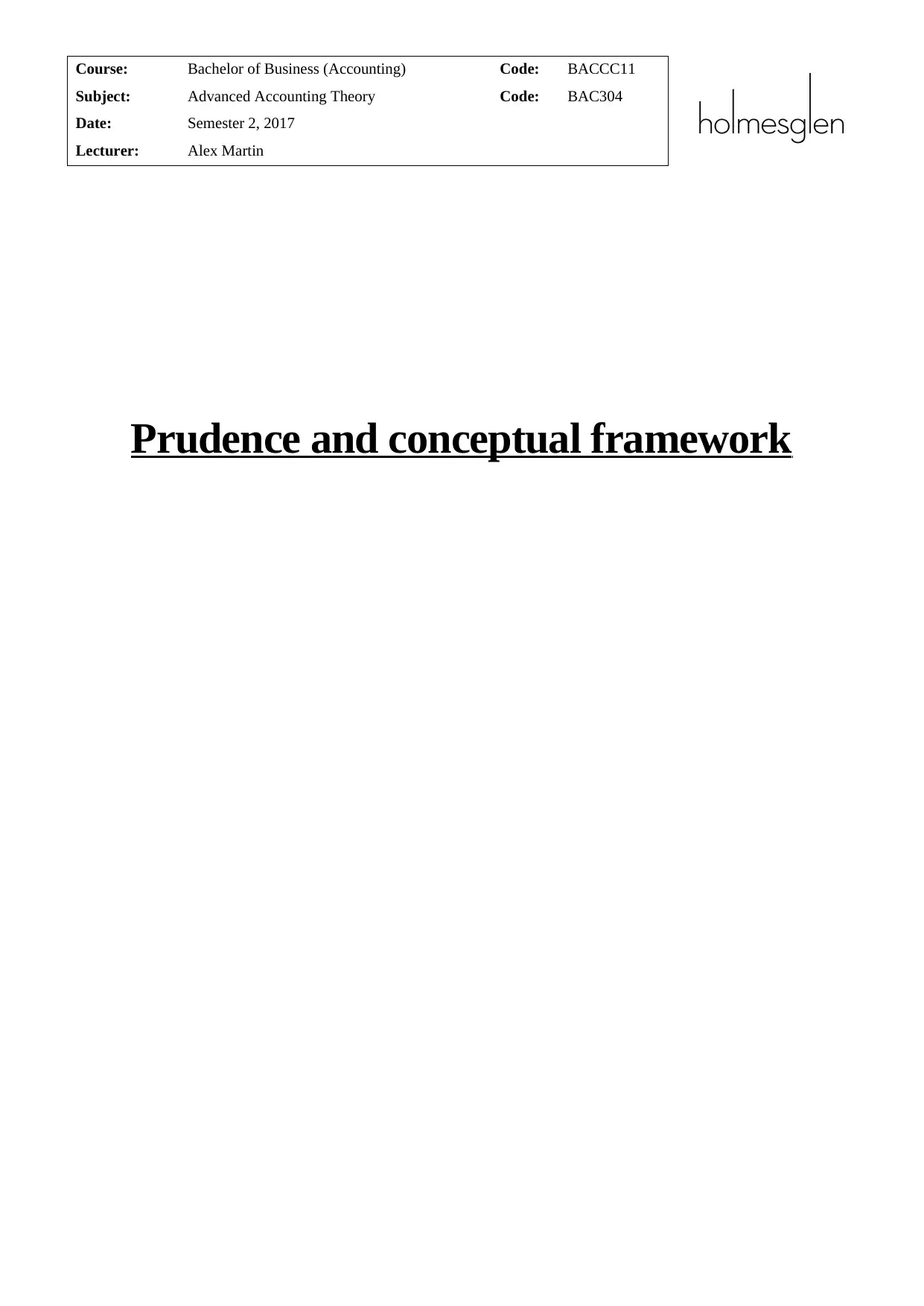
Course: Bachelor of Business (Accounting) Code: BACCC11
Subject: Advanced Accounting Theory Code: BAC304
Date: Semester 2, 2017
Lecturer: Alex Martin
Prudence and conceptual framework
Subject: Advanced Accounting Theory Code: BAC304
Date: Semester 2, 2017
Lecturer: Alex Martin
Prudence and conceptual framework
Paraphrase This Document
Need a fresh take? Get an instant paraphrase of this document with our AI Paraphraser
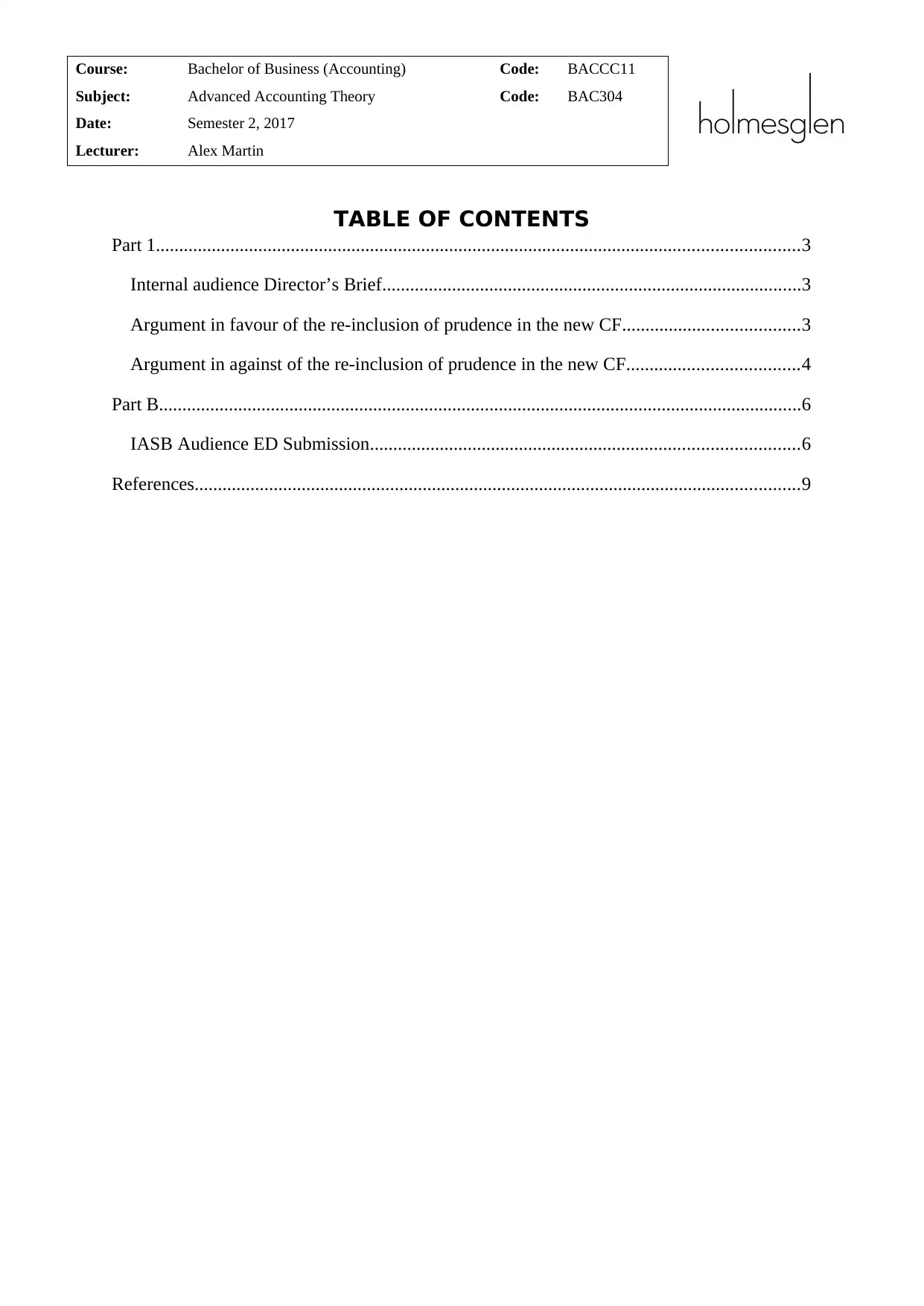
Course: Bachelor of Business (Accounting) Code: BACCC11
Subject: Advanced Accounting Theory Code: BAC304
Date: Semester 2, 2017
Lecturer: Alex Martin
TABLE OF CONTENTS
Part 1..........................................................................................................................................3
Internal audience Director’s Brief..........................................................................................3
Argument in favour of the re-inclusion of prudence in the new CF......................................3
Argument in against of the re-inclusion of prudence in the new CF.....................................4
Part B..........................................................................................................................................6
IASB Audience ED Submission............................................................................................6
References..................................................................................................................................9
Subject: Advanced Accounting Theory Code: BAC304
Date: Semester 2, 2017
Lecturer: Alex Martin
TABLE OF CONTENTS
Part 1..........................................................................................................................................3
Internal audience Director’s Brief..........................................................................................3
Argument in favour of the re-inclusion of prudence in the new CF......................................3
Argument in against of the re-inclusion of prudence in the new CF.....................................4
Part B..........................................................................................................................................6
IASB Audience ED Submission............................................................................................6
References..................................................................................................................................9
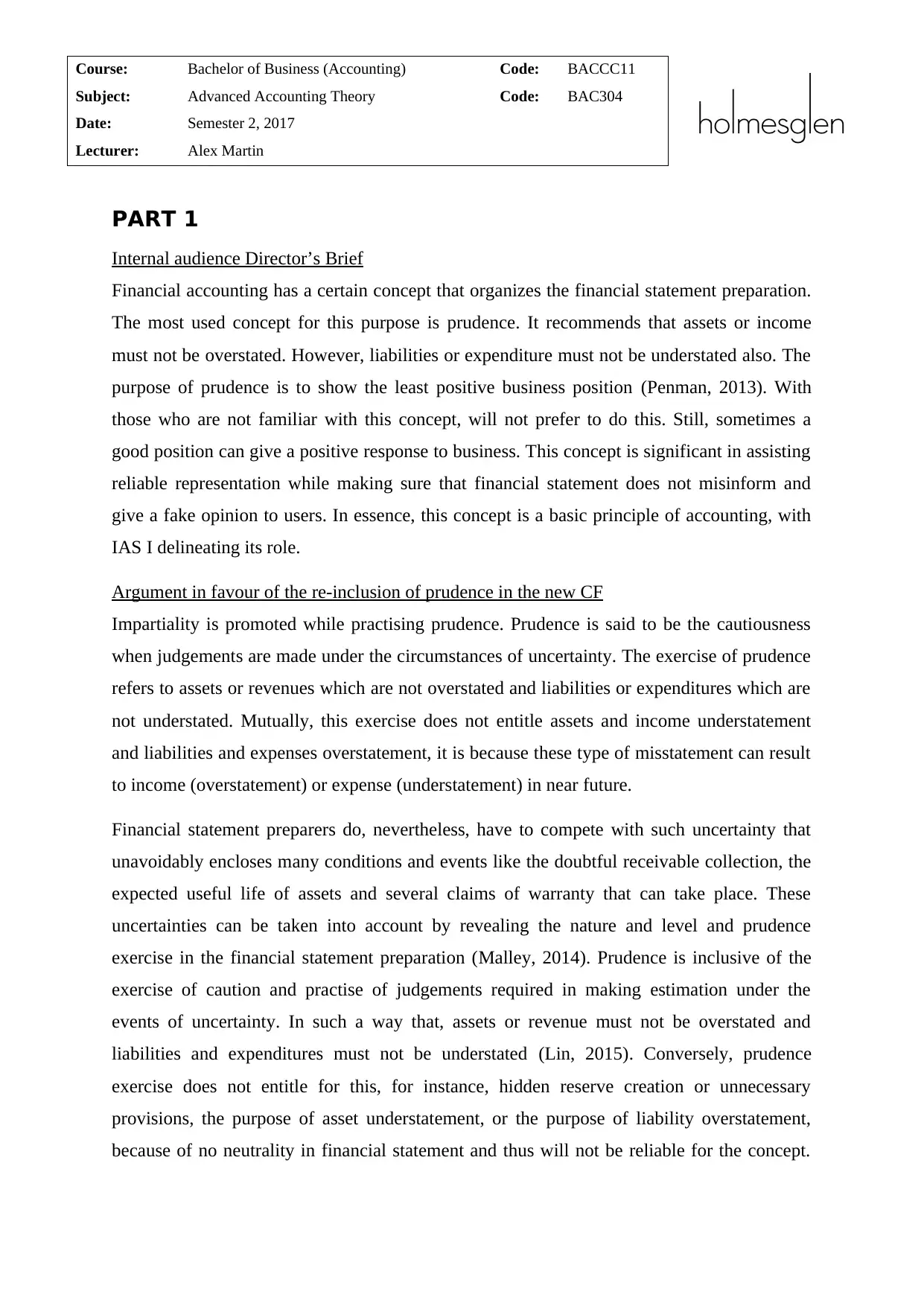
Course: Bachelor of Business (Accounting) Code: BACCC11
Subject: Advanced Accounting Theory Code: BAC304
Date: Semester 2, 2017
Lecturer: Alex Martin
PART 1
Internal audience Director’s Brief
Financial accounting has a certain concept that organizes the financial statement preparation.
The most used concept for this purpose is prudence. It recommends that assets or income
must not be overstated. However, liabilities or expenditure must not be understated also. The
purpose of prudence is to show the least positive business position (Penman, 2013). With
those who are not familiar with this concept, will not prefer to do this. Still, sometimes a
good position can give a positive response to business. This concept is significant in assisting
reliable representation while making sure that financial statement does not misinform and
give a fake opinion to users. In essence, this concept is a basic principle of accounting, with
IAS I delineating its role.
Argument in favour of the re-inclusion of prudence in the new CF
Impartiality is promoted while practising prudence. Prudence is said to be the cautiousness
when judgements are made under the circumstances of uncertainty. The exercise of prudence
refers to assets or revenues which are not overstated and liabilities or expenditures which are
not understated. Mutually, this exercise does not entitle assets and income understatement
and liabilities and expenses overstatement, it is because these type of misstatement can result
to income (overstatement) or expense (understatement) in near future.
Financial statement preparers do, nevertheless, have to compete with such uncertainty that
unavoidably encloses many conditions and events like the doubtful receivable collection, the
expected useful life of assets and several claims of warranty that can take place. These
uncertainties can be taken into account by revealing the nature and level and prudence
exercise in the financial statement preparation (Malley, 2014). Prudence is inclusive of the
exercise of caution and practise of judgements required in making estimation under the
events of uncertainty. In such a way that, assets or revenue must not be overstated and
liabilities and expenditures must not be understated (Lin, 2015). Conversely, prudence
exercise does not entitle for this, for instance, hidden reserve creation or unnecessary
provisions, the purpose of asset understatement, or the purpose of liability overstatement,
because of no neutrality in financial statement and thus will not be reliable for the concept.
Subject: Advanced Accounting Theory Code: BAC304
Date: Semester 2, 2017
Lecturer: Alex Martin
PART 1
Internal audience Director’s Brief
Financial accounting has a certain concept that organizes the financial statement preparation.
The most used concept for this purpose is prudence. It recommends that assets or income
must not be overstated. However, liabilities or expenditure must not be understated also. The
purpose of prudence is to show the least positive business position (Penman, 2013). With
those who are not familiar with this concept, will not prefer to do this. Still, sometimes a
good position can give a positive response to business. This concept is significant in assisting
reliable representation while making sure that financial statement does not misinform and
give a fake opinion to users. In essence, this concept is a basic principle of accounting, with
IAS I delineating its role.
Argument in favour of the re-inclusion of prudence in the new CF
Impartiality is promoted while practising prudence. Prudence is said to be the cautiousness
when judgements are made under the circumstances of uncertainty. The exercise of prudence
refers to assets or revenues which are not overstated and liabilities or expenditures which are
not understated. Mutually, this exercise does not entitle assets and income understatement
and liabilities and expenses overstatement, it is because these type of misstatement can result
to income (overstatement) or expense (understatement) in near future.
Financial statement preparers do, nevertheless, have to compete with such uncertainty that
unavoidably encloses many conditions and events like the doubtful receivable collection, the
expected useful life of assets and several claims of warranty that can take place. These
uncertainties can be taken into account by revealing the nature and level and prudence
exercise in the financial statement preparation (Malley, 2014). Prudence is inclusive of the
exercise of caution and practise of judgements required in making estimation under the
events of uncertainty. In such a way that, assets or revenue must not be overstated and
liabilities and expenditures must not be understated (Lin, 2015). Conversely, prudence
exercise does not entitle for this, for instance, hidden reserve creation or unnecessary
provisions, the purpose of asset understatement, or the purpose of liability overstatement,
because of no neutrality in financial statement and thus will not be reliable for the concept.
⊘ This is a preview!⊘
Do you want full access?
Subscribe today to unlock all pages.

Trusted by 1+ million students worldwide

Course: Bachelor of Business (Accounting) Code: BACCC11
Subject: Advanced Accounting Theory Code: BAC304
Date: Semester 2, 2017
Lecturer: Alex Martin
On the other hand, most users pass comments regarding this issue, expressing a view that a
reference to prudence must be applicable in accounting provisions of Conceptual Framework.
They provided some reasons which are enumerated as below:
a) Standards, existing and planned, both make use of accounting treatments that some
view as encouraged by approach for prudence. This, it is significant to justify
prudence in the accounting provisions of Conceptual Framework so that it can be
applied in a continuous manner.
b) Prudence is required to the management of counteract.
c) Investors also show concern regarding the hazardous risk than advantageous potential.
Prudence assists to deal with this concern (van Mourik and Katsuo, 2014).
d) Research done by academics has suggested certain forms of conservatism, it is
concept same like prudence, it has a role in financial reporting. Conversely, different
viewpoints were placed regarding what form will be not useful, at what time and why.
e) Prudence exercise assists to line up the managers and shareholders interest can make a
reduction in hazards (ACCA. Prudence and IFRS. 2014).
f) Financial crises had justified the requirement of prudence while making estimations.
Argument in against of the re-inclusion of prudence in the new CF
This section is based on analysis of arguments which are against in making use of prudence
in the conceptual framework. In such cases, the argument is articulated thoroughly in italics,
and further, the response is provided.
Basically, prudence is not considered to be a useful method because it is formless.
Particularly, this concept cannot help in questioning how much to apply in a situation. Most
of the concepts are open to this similar analysis. But some do not, for instance, have an extent
for the relevance measurement (Burton and Jermakowicz, 2015). In addition to, it must be
kept in mind that prudence takes place at the time of uncertainty, and by considering this
aspect it would theoretically incompatible to release prudence because it is too vague.
Instead, it is essentially an indistinct concept, with this ambiguity being the primary purpose
for its presence in the first place as it is not a reason for the elimination of this concept from
the Framework.
Subject: Advanced Accounting Theory Code: BAC304
Date: Semester 2, 2017
Lecturer: Alex Martin
On the other hand, most users pass comments regarding this issue, expressing a view that a
reference to prudence must be applicable in accounting provisions of Conceptual Framework.
They provided some reasons which are enumerated as below:
a) Standards, existing and planned, both make use of accounting treatments that some
view as encouraged by approach for prudence. This, it is significant to justify
prudence in the accounting provisions of Conceptual Framework so that it can be
applied in a continuous manner.
b) Prudence is required to the management of counteract.
c) Investors also show concern regarding the hazardous risk than advantageous potential.
Prudence assists to deal with this concern (van Mourik and Katsuo, 2014).
d) Research done by academics has suggested certain forms of conservatism, it is
concept same like prudence, it has a role in financial reporting. Conversely, different
viewpoints were placed regarding what form will be not useful, at what time and why.
e) Prudence exercise assists to line up the managers and shareholders interest can make a
reduction in hazards (ACCA. Prudence and IFRS. 2014).
f) Financial crises had justified the requirement of prudence while making estimations.
Argument in against of the re-inclusion of prudence in the new CF
This section is based on analysis of arguments which are against in making use of prudence
in the conceptual framework. In such cases, the argument is articulated thoroughly in italics,
and further, the response is provided.
Basically, prudence is not considered to be a useful method because it is formless.
Particularly, this concept cannot help in questioning how much to apply in a situation. Most
of the concepts are open to this similar analysis. But some do not, for instance, have an extent
for the relevance measurement (Burton and Jermakowicz, 2015). In addition to, it must be
kept in mind that prudence takes place at the time of uncertainty, and by considering this
aspect it would theoretically incompatible to release prudence because it is too vague.
Instead, it is essentially an indistinct concept, with this ambiguity being the primary purpose
for its presence in the first place as it is not a reason for the elimination of this concept from
the Framework.
Paraphrase This Document
Need a fresh take? Get an instant paraphrase of this document with our AI Paraphraser
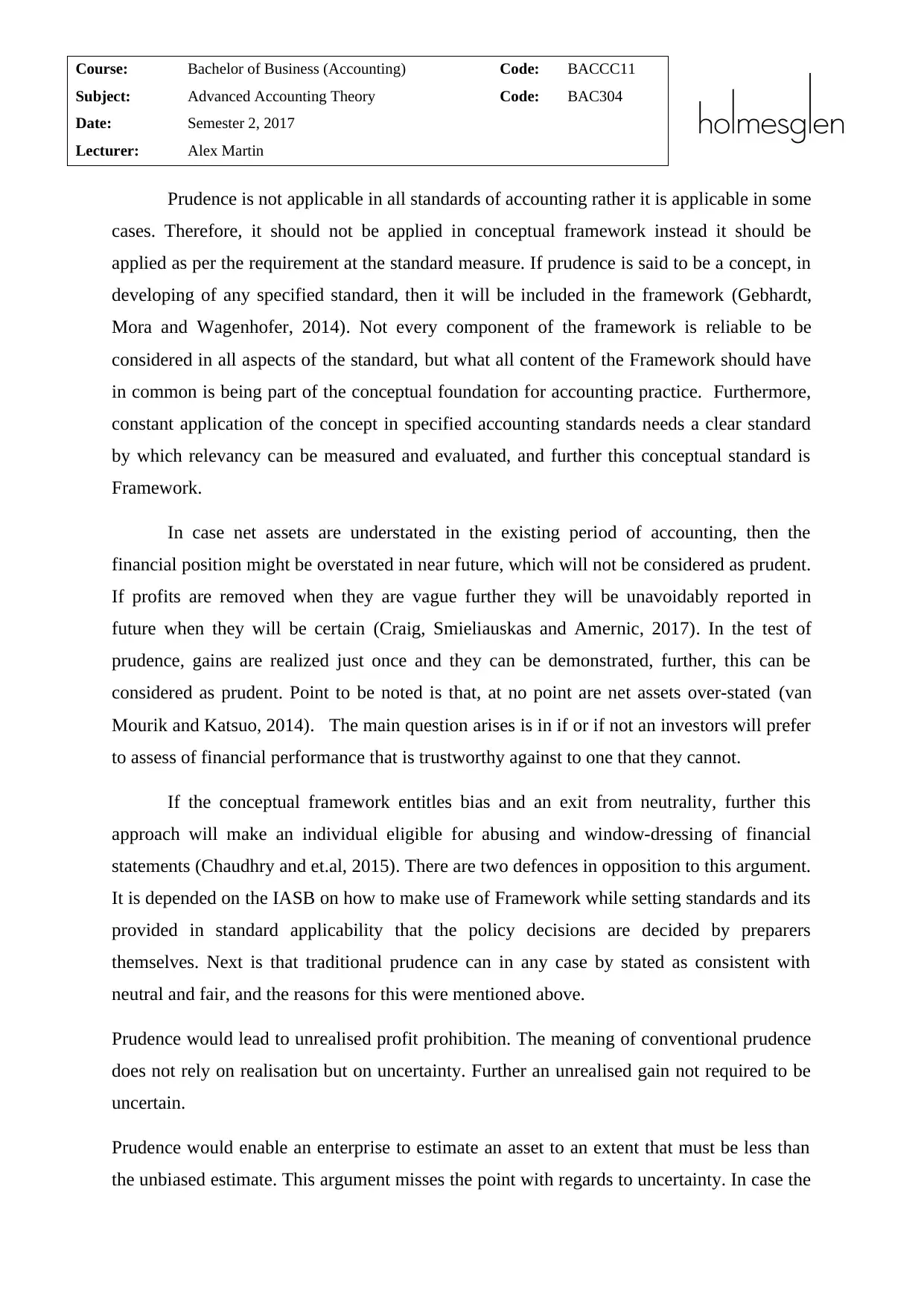
Course: Bachelor of Business (Accounting) Code: BACCC11
Subject: Advanced Accounting Theory Code: BAC304
Date: Semester 2, 2017
Lecturer: Alex Martin
Prudence is not applicable in all standards of accounting rather it is applicable in some
cases. Therefore, it should not be applied in conceptual framework instead it should be
applied as per the requirement at the standard measure. If prudence is said to be a concept, in
developing of any specified standard, then it will be included in the framework (Gebhardt,
Mora and Wagenhofer, 2014). Not every component of the framework is reliable to be
considered in all aspects of the standard, but what all content of the Framework should have
in common is being part of the conceptual foundation for accounting practice. Furthermore,
constant application of the concept in specified accounting standards needs a clear standard
by which relevancy can be measured and evaluated, and further this conceptual standard is
Framework.
In case net assets are understated in the existing period of accounting, then the
financial position might be overstated in near future, which will not be considered as prudent.
If profits are removed when they are vague further they will be unavoidably reported in
future when they will be certain (Craig, Smieliauskas and Amernic, 2017). In the test of
prudence, gains are realized just once and they can be demonstrated, further, this can be
considered as prudent. Point to be noted is that, at no point are net assets over-stated (van
Mourik and Katsuo, 2014). The main question arises is in if or if not an investors will prefer
to assess of financial performance that is trustworthy against to one that they cannot.
If the conceptual framework entitles bias and an exit from neutrality, further this
approach will make an individual eligible for abusing and window-dressing of financial
statements (Chaudhry and et.al, 2015). There are two defences in opposition to this argument.
It is depended on the IASB on how to make use of Framework while setting standards and its
provided in standard applicability that the policy decisions are decided by preparers
themselves. Next is that traditional prudence can in any case by stated as consistent with
neutral and fair, and the reasons for this were mentioned above.
Prudence would lead to unrealised profit prohibition. The meaning of conventional prudence
does not rely on realisation but on uncertainty. Further an unrealised gain not required to be
uncertain.
Prudence would enable an enterprise to estimate an asset to an extent that must be less than
the unbiased estimate. This argument misses the point with regards to uncertainty. In case the
Subject: Advanced Accounting Theory Code: BAC304
Date: Semester 2, 2017
Lecturer: Alex Martin
Prudence is not applicable in all standards of accounting rather it is applicable in some
cases. Therefore, it should not be applied in conceptual framework instead it should be
applied as per the requirement at the standard measure. If prudence is said to be a concept, in
developing of any specified standard, then it will be included in the framework (Gebhardt,
Mora and Wagenhofer, 2014). Not every component of the framework is reliable to be
considered in all aspects of the standard, but what all content of the Framework should have
in common is being part of the conceptual foundation for accounting practice. Furthermore,
constant application of the concept in specified accounting standards needs a clear standard
by which relevancy can be measured and evaluated, and further this conceptual standard is
Framework.
In case net assets are understated in the existing period of accounting, then the
financial position might be overstated in near future, which will not be considered as prudent.
If profits are removed when they are vague further they will be unavoidably reported in
future when they will be certain (Craig, Smieliauskas and Amernic, 2017). In the test of
prudence, gains are realized just once and they can be demonstrated, further, this can be
considered as prudent. Point to be noted is that, at no point are net assets over-stated (van
Mourik and Katsuo, 2014). The main question arises is in if or if not an investors will prefer
to assess of financial performance that is trustworthy against to one that they cannot.
If the conceptual framework entitles bias and an exit from neutrality, further this
approach will make an individual eligible for abusing and window-dressing of financial
statements (Chaudhry and et.al, 2015). There are two defences in opposition to this argument.
It is depended on the IASB on how to make use of Framework while setting standards and its
provided in standard applicability that the policy decisions are decided by preparers
themselves. Next is that traditional prudence can in any case by stated as consistent with
neutral and fair, and the reasons for this were mentioned above.
Prudence would lead to unrealised profit prohibition. The meaning of conventional prudence
does not rely on realisation but on uncertainty. Further an unrealised gain not required to be
uncertain.
Prudence would enable an enterprise to estimate an asset to an extent that must be less than
the unbiased estimate. This argument misses the point with regards to uncertainty. In case the
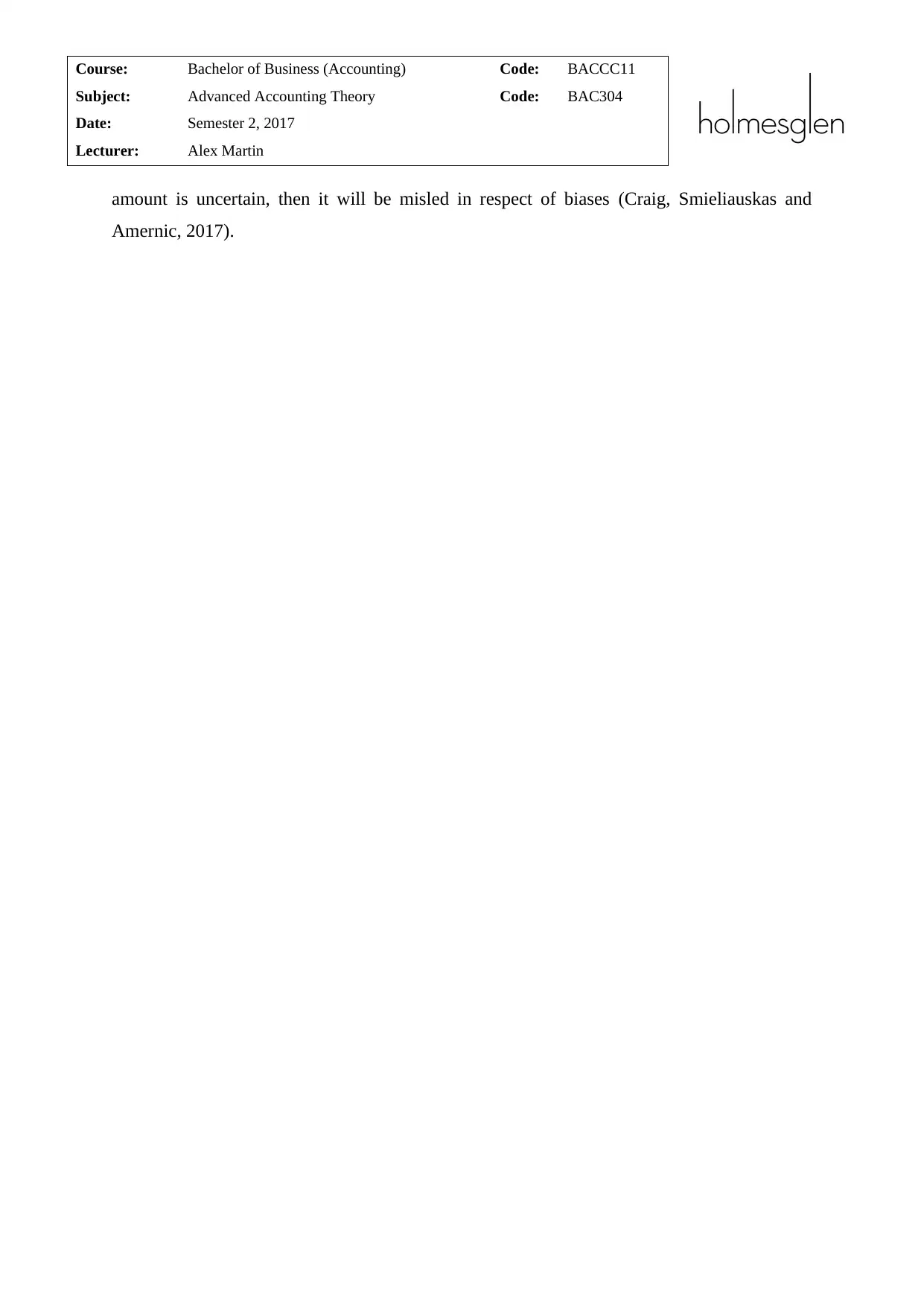
Course: Bachelor of Business (Accounting) Code: BACCC11
Subject: Advanced Accounting Theory Code: BAC304
Date: Semester 2, 2017
Lecturer: Alex Martin
amount is uncertain, then it will be misled in respect of biases (Craig, Smieliauskas and
Amernic, 2017).
Subject: Advanced Accounting Theory Code: BAC304
Date: Semester 2, 2017
Lecturer: Alex Martin
amount is uncertain, then it will be misled in respect of biases (Craig, Smieliauskas and
Amernic, 2017).
⊘ This is a preview!⊘
Do you want full access?
Subscribe today to unlock all pages.

Trusted by 1+ million students worldwide

Course: Bachelor of Business (Accounting) Code: BACCC11
Subject: Advanced Accounting Theory Code: BAC304
Date: Semester 2, 2017
Lecturer: Alex Martin
PART B
IASB Audience ED Submission
XYZ company
Sydney 3500
Date:
Mr Price
Executive Director of Corporate Advisory
Corporate Advisory Group
Re: draft submission letter to the IASB
Respected board
The term ‘prudence’ in accounting is utilised in different ways having a different sense. In
particular, there are two primary divergent perceptions of prudence which are prominent in
the debate on the conceptual framework. In accordance with the IASB; prudence is
consistent with neutrality and essential for interpretation for careful judgement in
accounting. Second perception in accordance with the traditional understanding of
prudence in accounting practice which states that prudence is the solicitation of a complex
threshold of verifiability for the acknowledgement of gains in comparison to losses.
The International Accounting Standards Board recently issued an Exposure Draft of a new
and revised framework regarding Financial Reporting. For this, IASB tends to re-establish
prudence that will make financial statements more useful (Zhang and Andrew, 2014). On
the face of it, this sounds like a clear-cut decision, after all, prudence is recognized as an
asset on daily basis of life. Although, prudence application to accounting provisions is
complex than it is to a conduct of an individual. This vagueness has created confusion in
order to remove any reference to prudence in 2010, during the last revision of the
Conceptual Framework, choosing to depend on other ways of defining good quality in
terms of financial reporting (Gebhardt, Mora and Wagenhofer, 2014).
Subject: Advanced Accounting Theory Code: BAC304
Date: Semester 2, 2017
Lecturer: Alex Martin
PART B
IASB Audience ED Submission
XYZ company
Sydney 3500
Date:
Mr Price
Executive Director of Corporate Advisory
Corporate Advisory Group
Re: draft submission letter to the IASB
Respected board
The term ‘prudence’ in accounting is utilised in different ways having a different sense. In
particular, there are two primary divergent perceptions of prudence which are prominent in
the debate on the conceptual framework. In accordance with the IASB; prudence is
consistent with neutrality and essential for interpretation for careful judgement in
accounting. Second perception in accordance with the traditional understanding of
prudence in accounting practice which states that prudence is the solicitation of a complex
threshold of verifiability for the acknowledgement of gains in comparison to losses.
The International Accounting Standards Board recently issued an Exposure Draft of a new
and revised framework regarding Financial Reporting. For this, IASB tends to re-establish
prudence that will make financial statements more useful (Zhang and Andrew, 2014). On
the face of it, this sounds like a clear-cut decision, after all, prudence is recognized as an
asset on daily basis of life. Although, prudence application to accounting provisions is
complex than it is to a conduct of an individual. This vagueness has created confusion in
order to remove any reference to prudence in 2010, during the last revision of the
Conceptual Framework, choosing to depend on other ways of defining good quality in
terms of financial reporting (Gebhardt, Mora and Wagenhofer, 2014).
Paraphrase This Document
Need a fresh take? Get an instant paraphrase of this document with our AI Paraphraser
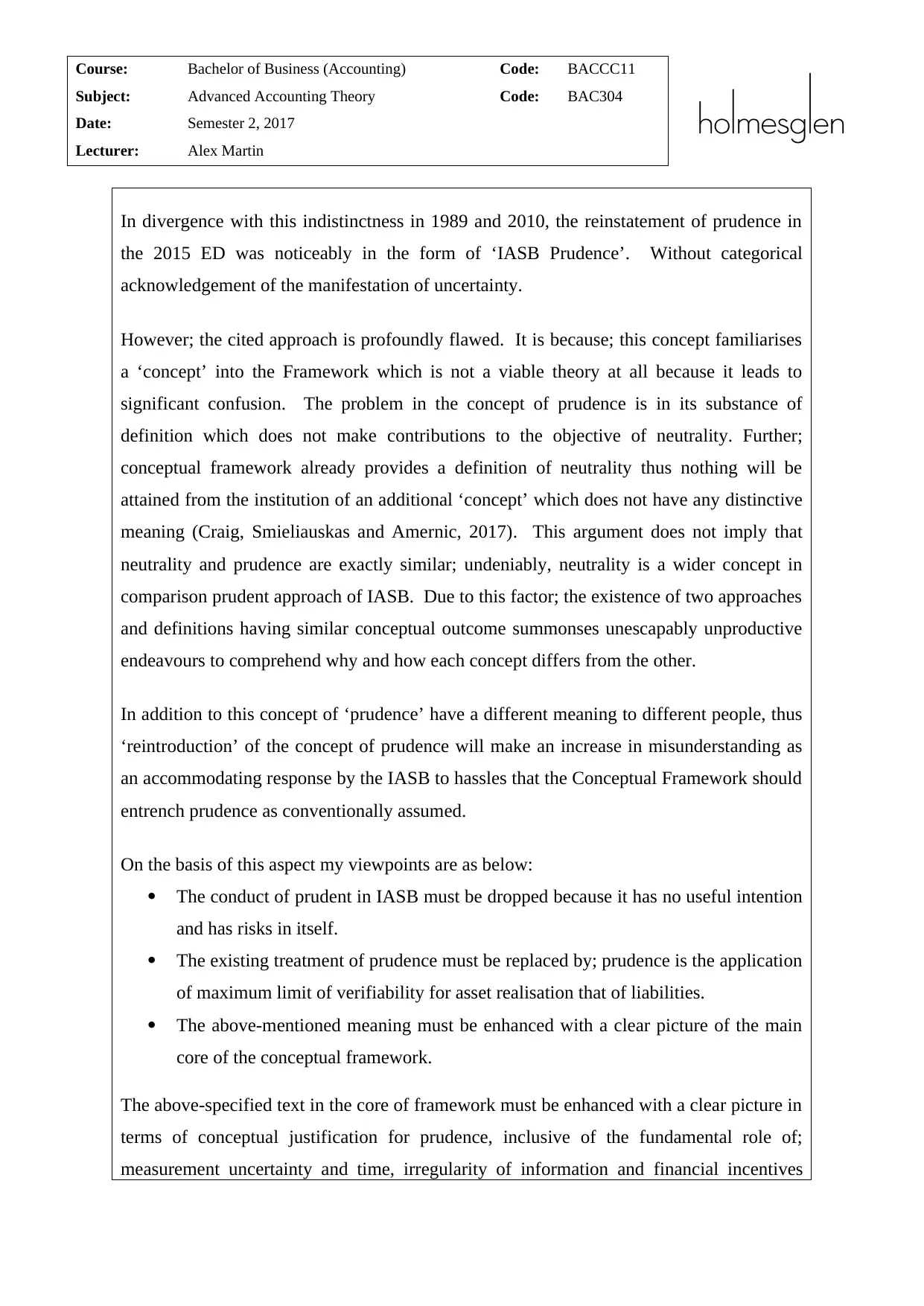
Course: Bachelor of Business (Accounting) Code: BACCC11
Subject: Advanced Accounting Theory Code: BAC304
Date: Semester 2, 2017
Lecturer: Alex Martin
In divergence with this indistinctness in 1989 and 2010, the reinstatement of prudence in
the 2015 ED was noticeably in the form of ‘IASB Prudence’. Without categorical
acknowledgement of the manifestation of uncertainty.
However; the cited approach is profoundly flawed. It is because; this concept familiarises
a ‘concept’ into the Framework which is not a viable theory at all because it leads to
significant confusion. The problem in the concept of prudence is in its substance of
definition which does not make contributions to the objective of neutrality. Further;
conceptual framework already provides a definition of neutrality thus nothing will be
attained from the institution of an additional ‘concept’ which does not have any distinctive
meaning (Craig, Smieliauskas and Amernic, 2017). This argument does not imply that
neutrality and prudence are exactly similar; undeniably, neutrality is a wider concept in
comparison prudent approach of IASB. Due to this factor; the existence of two approaches
and definitions having similar conceptual outcome summonses unescapably unproductive
endeavours to comprehend why and how each concept differs from the other.
In addition to this concept of ‘prudence’ have a different meaning to different people, thus
‘reintroduction’ of the concept of prudence will make an increase in misunderstanding as
an accommodating response by the IASB to hassles that the Conceptual Framework should
entrench prudence as conventionally assumed.
On the basis of this aspect my viewpoints are as below:
The conduct of prudent in IASB must be dropped because it has no useful intention
and has risks in itself.
The existing treatment of prudence must be replaced by; prudence is the application
of maximum limit of verifiability for asset realisation that of liabilities.
The above-mentioned meaning must be enhanced with a clear picture of the main
core of the conceptual framework.
The above-specified text in the core of framework must be enhanced with a clear picture in
terms of conceptual justification for prudence, inclusive of the fundamental role of;
measurement uncertainty and time, irregularity of information and financial incentives
Subject: Advanced Accounting Theory Code: BAC304
Date: Semester 2, 2017
Lecturer: Alex Martin
In divergence with this indistinctness in 1989 and 2010, the reinstatement of prudence in
the 2015 ED was noticeably in the form of ‘IASB Prudence’. Without categorical
acknowledgement of the manifestation of uncertainty.
However; the cited approach is profoundly flawed. It is because; this concept familiarises
a ‘concept’ into the Framework which is not a viable theory at all because it leads to
significant confusion. The problem in the concept of prudence is in its substance of
definition which does not make contributions to the objective of neutrality. Further;
conceptual framework already provides a definition of neutrality thus nothing will be
attained from the institution of an additional ‘concept’ which does not have any distinctive
meaning (Craig, Smieliauskas and Amernic, 2017). This argument does not imply that
neutrality and prudence are exactly similar; undeniably, neutrality is a wider concept in
comparison prudent approach of IASB. Due to this factor; the existence of two approaches
and definitions having similar conceptual outcome summonses unescapably unproductive
endeavours to comprehend why and how each concept differs from the other.
In addition to this concept of ‘prudence’ have a different meaning to different people, thus
‘reintroduction’ of the concept of prudence will make an increase in misunderstanding as
an accommodating response by the IASB to hassles that the Conceptual Framework should
entrench prudence as conventionally assumed.
On the basis of this aspect my viewpoints are as below:
The conduct of prudent in IASB must be dropped because it has no useful intention
and has risks in itself.
The existing treatment of prudence must be replaced by; prudence is the application
of maximum limit of verifiability for asset realisation that of liabilities.
The above-mentioned meaning must be enhanced with a clear picture of the main
core of the conceptual framework.
The above-specified text in the core of framework must be enhanced with a clear picture in
terms of conceptual justification for prudence, inclusive of the fundamental role of;
measurement uncertainty and time, irregularity of information and financial incentives
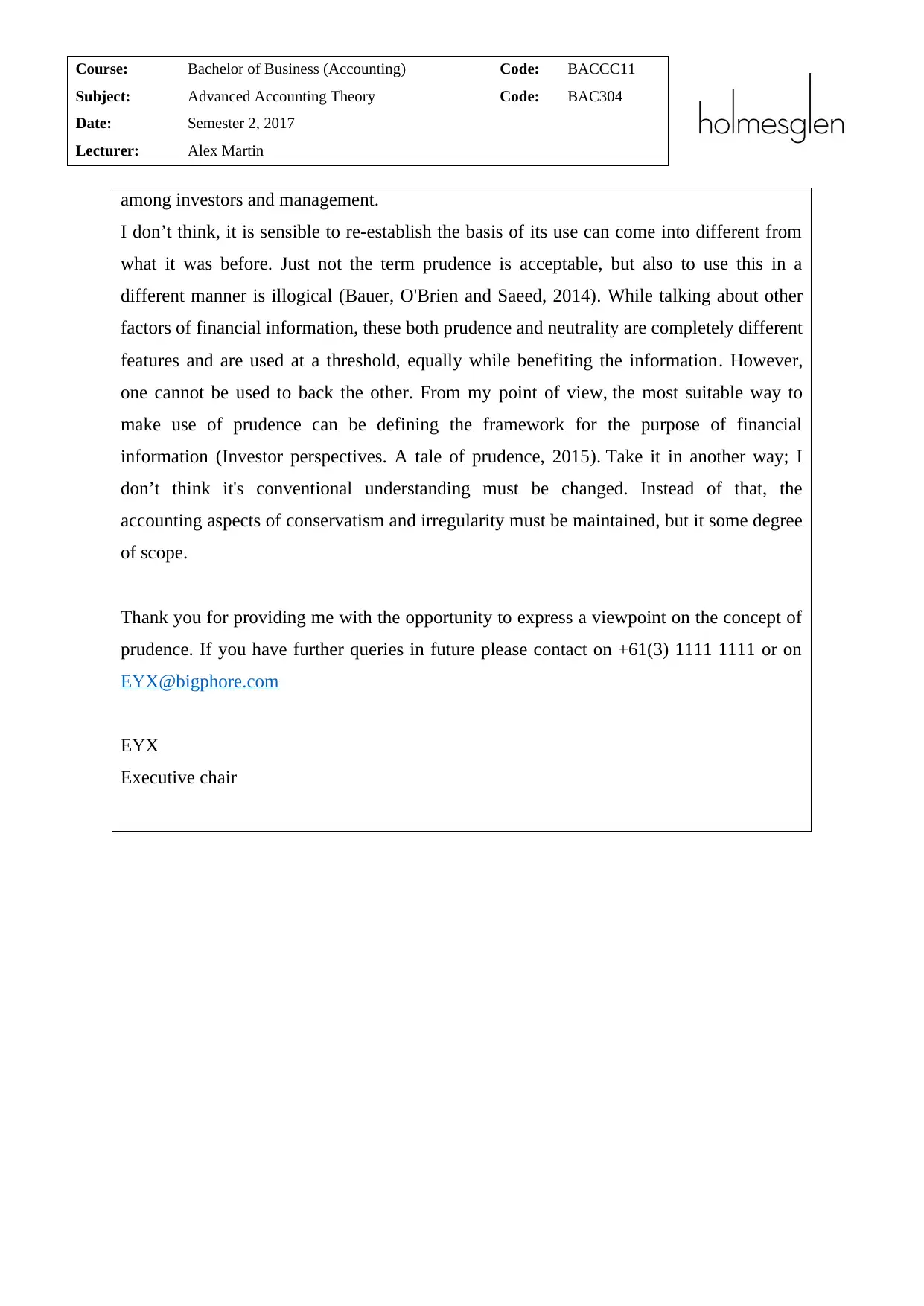
Course: Bachelor of Business (Accounting) Code: BACCC11
Subject: Advanced Accounting Theory Code: BAC304
Date: Semester 2, 2017
Lecturer: Alex Martin
among investors and management.
I don’t think, it is sensible to re-establish the basis of its use can come into different from
what it was before. Just not the term prudence is acceptable, but also to use this in a
different manner is illogical (Bauer, O'Brien and Saeed, 2014). While talking about other
factors of financial information, these both prudence and neutrality are completely different
features and are used at a threshold, equally while benefiting the information. However,
one cannot be used to back the other. From my point of view, the most suitable way to
make use of prudence can be defining the framework for the purpose of financial
information (Investor perspectives. A tale of prudence, 2015). Take it in another way; I
don’t think it's conventional understanding must be changed. Instead of that, the
accounting aspects of conservatism and irregularity must be maintained, but it some degree
of scope.
Thank you for providing me with the opportunity to express a viewpoint on the concept of
prudence. If you have further queries in future please contact on +61(3) 1111 1111 or on
EYX@bigphore.com
EYX
Executive chair
Subject: Advanced Accounting Theory Code: BAC304
Date: Semester 2, 2017
Lecturer: Alex Martin
among investors and management.
I don’t think, it is sensible to re-establish the basis of its use can come into different from
what it was before. Just not the term prudence is acceptable, but also to use this in a
different manner is illogical (Bauer, O'Brien and Saeed, 2014). While talking about other
factors of financial information, these both prudence and neutrality are completely different
features and are used at a threshold, equally while benefiting the information. However,
one cannot be used to back the other. From my point of view, the most suitable way to
make use of prudence can be defining the framework for the purpose of financial
information (Investor perspectives. A tale of prudence, 2015). Take it in another way; I
don’t think it's conventional understanding must be changed. Instead of that, the
accounting aspects of conservatism and irregularity must be maintained, but it some degree
of scope.
Thank you for providing me with the opportunity to express a viewpoint on the concept of
prudence. If you have further queries in future please contact on +61(3) 1111 1111 or on
EYX@bigphore.com
EYX
Executive chair
⊘ This is a preview!⊘
Do you want full access?
Subscribe today to unlock all pages.

Trusted by 1+ million students worldwide
1 out of 9
Related Documents
Your All-in-One AI-Powered Toolkit for Academic Success.
+13062052269
info@desklib.com
Available 24*7 on WhatsApp / Email
![[object Object]](/_next/static/media/star-bottom.7253800d.svg)
Unlock your academic potential
Copyright © 2020–2025 A2Z Services. All Rights Reserved. Developed and managed by ZUCOL.




